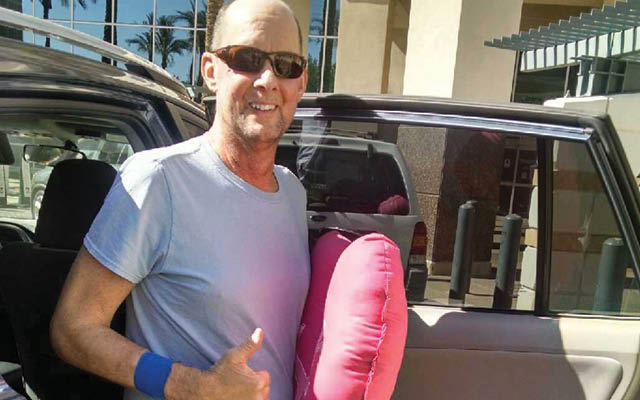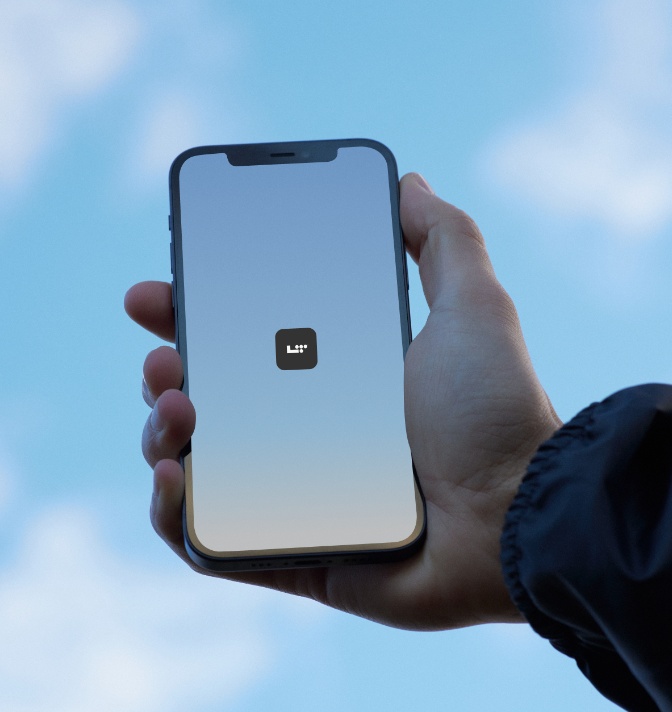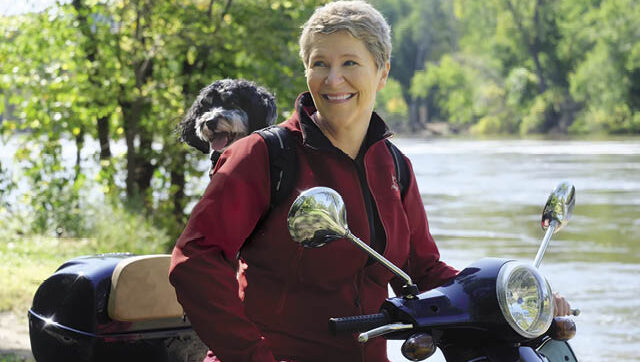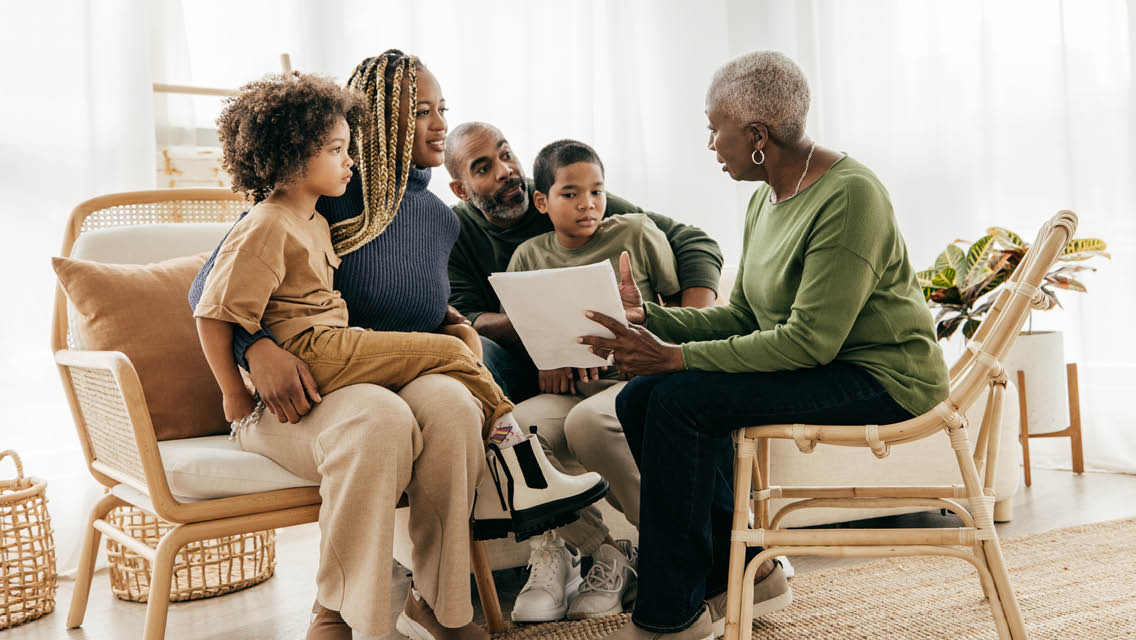The first sneeze was what made it real for me.
I was sitting in my living room last May when I felt it coming on, and it scared me at first. With something like a hundred staples across my chest, I knew it would hurt. I took a deep, full breath; the air that came out startled me.
My brother Scott ducked his head in from the kitchen. “What was that?”
“I sneezed!” I told him. I could hardly believe it. I hadn’t sneezed normally in years.
“Huh,” Scott said. “At least we know the lungs work.”
Out of Breath
In 2007 I was living an active life. I’d often finish my workday in corporate information technology and head straight to Life Time in Coon Rapids, Minn. Depending on the day, I’d play an hour of racquetball, do some weightlifting, and perhaps round out my evening with some yoga. On summer weekends, I’d go water-skiing every chance I could, or I’d meet up with friends for a tennis game or a round of golf.
Fitness was part of who I was; I felt most like myself when I was moving my body.
Then in January 2008 I caught a cold, and it never went away. At the time, I was preparing for my first sprint triathlon, and I started feeling short of breath during my workouts. My doctor gave me an inhaler, thinking I had exercise-induced asthma, but it didn’t do any good. He ran blood test after blood test: all negative. He prescribed a few courses of antibiotics, and still my symptoms persisted.
It took nearly 11 months for doctors to figure out what was wrong. During this time, I could barely climb a flight of stairs without gasping for breath. As a lifelong exerciser who’d never smoked, I knew something wasn’t right. But I really had to advocate for myself in order to be heard.
Eventually, my primary physician referred me to a pulmonologist, who called one day to tell me she’d cracked my case. “It’s called Alpha-1 antitrypsin deficiency,” she told me. “It’s genetic emphysema.”
I’d never heard of Alpha-1, but her explanation left me stunned. My mother died of emphysema. I recalled the oxygen tank at her bedside, how my six siblings and I had watched her quality of life slowly fade away. No way, I thought. I can’t live like that.
Leaving the Pity Party
My liver doesn’t produce the Alpha-1 antitrypsin protein needed to protect my lungs. In the time it took me to learn this, I’d lost about 40 percent of my lung function. Lots of people with Alpha-1 eventually develop chronic obstructive pulmonary disease; many are told they have about five years to live.
Suddenly, I was scheduling my life around doctor appointments instead of fitness class. I also started receiving weekly intravenous plasma treatments at home. Alpha-1 is a terminal disease, so the treatments aren’t a cure, but they helped slow the progression by replacing the protein in my blood and quelling the inflammation in my lungs.
Instead of playing golf on the weekends, I spent my time online, learning more about Alpha-1 and finding contacts in the community. In 2008 I attended my first Alpha-1 national conference, where I met people who were living with my disease — many newly diagnosed, just like me — and physicians who had treated it.
I’ve returned nearly every year since then, and I’ve developed a strong nationwide support system through the Alpha-1 community. That camaraderie has helped keep me sane. Knowing other people who understand firsthand what I’m going through has been really transformative.
These days, when I reach out to people who have been recently diagnosed, I tell them it’s OK and normal to feel depressed about what they’ve lost, and to have a bit of a pity party.
What really matters, though, is how long you stay there, and whether you let it consume you.
I decided to leave my pity party early. I knew some people with my illness would be OK staying on the couch, reading a book or binge-watching TV, but that wasn’t me. I’d watched both of my parents die sick and bedridden. That was part of what motivated me to stay fit: I wanted to be healthy when I grew older. Nothing about my diagnosis changed that; I still wanted to be as active as I could be in the face of this disease.
I couldn’t work out like I had prior to my diagnosis. I didn’t have the endurance to go from one fitness class to the next, and I didn’t have the lung capacity for high-intensity cardio.
Still, I could ride the stationary bike and do light sets of biceps and triceps curls and leg presses. My strength wasn’t what it once was, but it kept me somewhat connected to the life I’d known before.
At first, I worked out mostly to maintain a sense of normalcy. But within a few years of my diagnosis, I had a new mission: preparing for a double lung transplant.
The Waiting Game
Once an Alpha-1 patient’s lung function has declined to the point where routine physical activities become impossible, a transplant is the only treatment option. That became my goal pretty early on, in part because my engagement with the community showed me how my disease could progress. I knew people who were on portable oxygen all day, who didn’t have the lung capacity to take a shower or go out to the grocery store.
My doctors wanted me to keep my own lungs as long as possible, because a transplant is a risky surgery, with a high potential for rejection and other complications. I didn’t want to wait so long for my new lungs that the rest of my body would be too weak to appreciate them.
For a long time, however, I was too healthy to meet the transplant criteria from the International Society for Heart and Lung Transplantation. This waiting period was a Catch-22. I kept working out as much as I could, because I knew that staying strong would increase my odds for a successful surgery and recovery. At the same time, I often felt as if I was biding my time, waiting to get sicker, watching my life become less and less like what it had been before.
I relocated to Phoenix in 2011, after the Minnesota winters proved too brutal for my lungs. It was a tough decision, even as I knew it was the best choice for my health: Minnesota was the only home I’d ever known — and moving away meant leaving behind my two teenage kids, Bri and Blake, who lived with my ex-wife in Stacy, Minn. Thankfully, they were very supportive. Within a few years, Bri graduated from high school and followed me to Arizona.
My employer allowed me to transfer to its Phoenix location and let me work from home one day a week so I could receive my plasma treatments. I’m incredibly fortunate to have had that kind of workplace support. I know lots of other people who haven’t been as lucky.
In time, I came to realize that the skills I’d honed at work were serving me well in my life as a patient. It’s nearly impossible to keep your head above water in a sea of copays and deductibles and insurance without some tech literacy. Still, I sometimes spent four or five hours a day on the phone with insurance companies, asking that they cover the drugs that were keeping me alive — and which cost more than $150,000 per year.
After I started collecting disability in 2016, I began working part-time for the company that provided my plasma drug. I traveled as much as I could to raise awareness among doctors about Alpha-1 and encourage early testing. The way I see it, if more doctors know about it, more people can start treatment before it’s too late for them.
A New Life
In the spring of 2019, my doctors agreed that it was time for me to get on the transplant list. Once you’re listed, though, you have to be ready to go right away, and I had to get my life in order first. I arranged for my brother Scott to come down from Seattle for a few months to help me through my recovery. The gift of his time and support was critical; they won’t even list you for a transplant if you don’t have a caregiver.
I made funeral arrangements, too. That might seem morbid, but I felt that my kids had already been through enough with my illness, and I didn’t want to leave them with those responsibilities if I didn’t make it through surgery.
That is also when I reached out to Experience Life to tell my story. Whether or not I survived, I wanted to document my experience so people could see the importance of organ and plasma donation. And I wanted to express my gratitude to my friends at Life Time, where I’d been a member for 23 years. For so long, my workouts had been the only stable thing in my life. Even as my disease progressed, I could go to the club in Tempe and feel supported and encouraged to stay as healthy as possible.
I got the call for my transplant on April 18, which is my son’s birthday. My surgery took place two days later, on my daughter’s birthday. I’d had a lot of friends whose transplants had failed, and I knew that could be my fate, too. But I tried to stay focused on how good my life could be afterward: going water-skiing again, competing in my first sprint triathlon, or just getting back to work.
Those things still feel a long way off, but my surgery was successful and my recovery has gone well. Scott was even able to go home a few weeks early.
About three months after surgery, my physical therapist told me I was further along than many of his six-month patients. I think a lot of that is due to my presurgery commitment to fitness. I had the core strength to support my body, and getting out of bed to exercise felt like a joy.
Most of my post-op issues have been limited to side effects from the medications I’m taking. My feet are swollen from the prednisone, and I developed type 2 diabetes because some of the drugs are affecting my pancreas. Still, I’d take those side effects a million times over for the new life these lungs have given me and for the future possibilities I can see.
I’d like to do a speaking tour someday, to tell people what it’s like to live with a terminal illness and how to keep your life and your body moving in spite of it. And after the one-year anniversary of my surgery, the transplant center will allow me to meet the donor family if they agree to it. I’m eager to tell them how grateful I am for their loved one’s donation and the incredible difference these lungs have made in my life.
When I woke up after my surgery, Bri handed me a pillow that several people — including my surgeon, she, and Blake — had signed. The pillow was shaped like a pair of lungs, and I was supposed to hug it when I sat up, to keep from putting weight on my arms while my sternum healed. “You’ve got this, Dad,” she had written. “Now we share a birthday.”
Ed’s Top 3 Success Strategies
1. Practice Gratitude. Ed’s diagnosis gave him a new perspective on health. “Don’t take breathing for granted,” he says. “If you have a healthy body, it’s a privilege and a gift.
2. Invest in what counts. “I had a good job, with good money,” Ed recalls. “I’ve had all the stuff. In the end, all that matters is your people: Who you love, and who loves you.”
3. Give back what you can. “Twenty people die every day waiting for an organ in the United States,” Ed explains. His IV treatments, which are developed from human plasma, kept his illness at bay — and his donor lungs have given him a new life.
This originally appeared as “Breathe Again” in the March 2020 print issue of Experience Life.





This Post Has One Comment
Hello Ed,
What a beautiful story and congratulations on surviving so well. I am new to this website and live in Australia. I’ve had a bout of flu (3 Covid RAT tests were neg) and I’ve been coughing for 2 weeks. Sometimes it’s been so bad I can’t lie down because that caused more coughing. I had to sleep (well try to) sitting up for a week. Like you, fitness is a priority in my life and I wanted to find a way to heal without antibiotics. In researching oregano oil (which I incidentally found in my cupboard this morning), I read that it can penetrate a biofilm which can cover the bacteria in the lungs. It’s very strong stuff and I worry that it might damage the bacteria in the microbiome. However, one dose this morning has helped bring up some phlegm — a welcome sight. I’ve also been taking Codral which has pseudoephedrine in it and has helped me to function although it didn’t help with the cough. My doctor gave me an inhaler and some nasal spray to stop the post-nasal drip going down to the lungs, both of which have helped.
I’ll continue to research the biofilm. All the best for your continued athleticism.
Regards
Deborah Lilly
Brisbane Qld